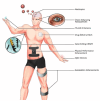Emerging Medical Technologies and Their Use in Bionic Repair and Human Augmentation
- PMID: 39061777
- PMCID: PMC11274085
- DOI: 10.3390/bioengineering11070695
Emerging Medical Technologies and Their Use in Bionic Repair and Human Augmentation
Abstract
As both the proportion of older people and the length of life increases globally, a rise in age-related degenerative diseases, disability, and prolonged dependency is projected. However, more sophisticated biomedical materials, as well as an improved understanding of human disease, is forecast to revolutionize the diagnosis and treatment of conditions ranging from osteoarthritis to Alzheimer's disease as well as impact disease prevention. Another, albeit quieter, revolution is also taking place within society: human augmentation. In this context, humans seek to improve themselves, metamorphosing through self-discipline or more recently, through use of emerging medical technologies, with the goal of transcending aging and mortality. In this review, and in the pursuit of improved medical care following aging, disease, disability, or injury, we first highlight cutting-edge and emerging materials-based neuroprosthetic technologies designed to restore limb or organ function. We highlight the potential for these technologies to be utilized to augment human performance beyond the range of natural performance. We discuss and explore the growing social movement of human augmentation and the idea that it is possible and desirable to use emerging technologies to push the boundaries of what it means to be a healthy human into the realm of superhuman performance and intelligence. This potential future capability is contrasted with limitations in the right-to-repair legislation, which may create challenges for patients. Now is the time for continued discussion of the ethical strategies for research, implementation, and long-term device sustainability or repair.
Keywords: biohacking; brain–machine interface; ethics; exoskeletons; human augmentation; neuroprosthetics.
Conflict of interest statement
This study was internally funded and none of the authors have any conflicts of interest to disclose.
Figures





References
-
- Bio-Implants—Global Market Outlook (2017–2026): Expected to Grow at a CAGR of 10.1% ResearchAndMarkets.com. 2018. [(accessed on 6 April 2024)]. Available online: https://www.businesswire.com/news/home/20181109005315/en/Bio-Implants---....
-
- Aging N.I. Why Population Aging Matters: A Global Perspective. National Institute on Aging, National Institutes of Health; Bethesda, MD, USA: 2017.
-
- He W., Goodkind D., Kowal P.R. An Aging World: 2015. U.S. Census Bureau; Suitland, MD, USA: 2016.
Publication types
LinkOut - more resources
Full Text Sources
Research Materials

